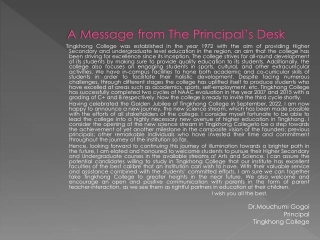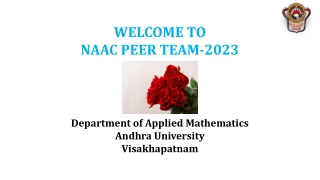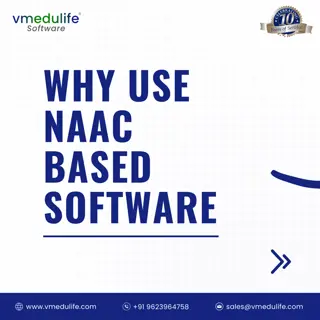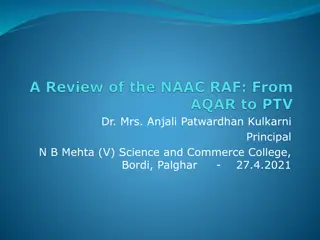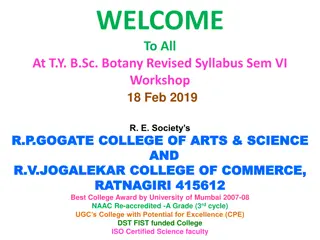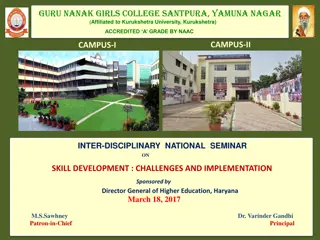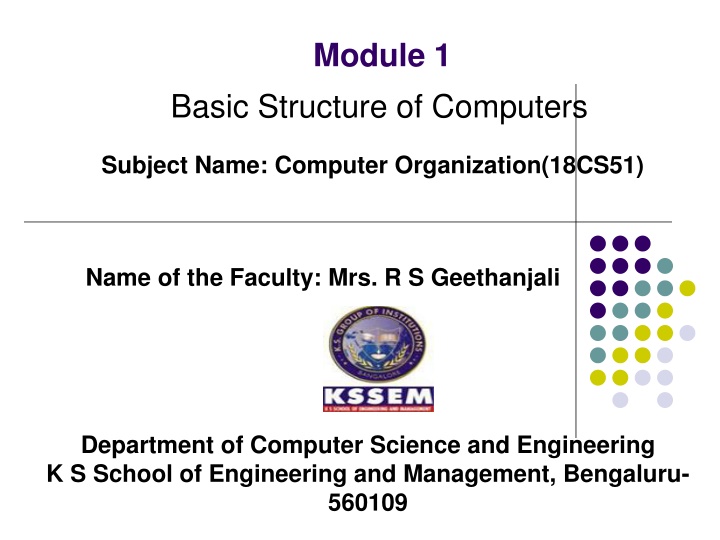
Computer Organization: Basic Concepts and Functional Units Overview
Explore the fundamentals of computer organization, covering topics such as basic operational concepts, bus structures, machine instructions, memory operations, addressing modes, and more. Understand the distinction between computer organization and computer architecture, learn about functional units like arithmetic, logic, memory, and control units. Delve into the information handled by computers through machine instructions and programs, and gain insights into CISC and RISC architectures.
Download Presentation

Please find below an Image/Link to download the presentation.
The content on the website is provided AS IS for your information and personal use only. It may not be sold, licensed, or shared on other websites without obtaining consent from the author. If you encounter any issues during the download, it is possible that the publisher has removed the file from their server.
You are allowed to download the files provided on this website for personal or commercial use, subject to the condition that they are used lawfully. All files are the property of their respective owners.
The content on the website is provided AS IS for your information and personal use only. It may not be sold, licensed, or shared on other websites without obtaining consent from the author.
E N D
Presentation Transcript
Module 1 Basic Structure of Computers Subject Name: Computer Organization(18CS51) Name of the Faculty: Mrs. R S Geethanjali Department of Computer Science and Engineering K S School of Engineering and Management, Bengaluru- 560109
Computer Organization Subject code: 18CS34 Textbook: 1. Carl Hamacher, Zvonko Vranesic, Safwat Zaky, Computer Organization, 5thEdition 2002. 2
Outline Basic Operational Concepts Bus Structures Basic Performance Equation Performance Measurement Machine Instructions and Programs Memory Operations Memory Operations Addressing Modes Encoding of Machine Instructions 3
Learning Objectives Understand structure peripherals Understand the concepts of programs as sequences or machine instructions. To analyse various addressing modes and machine instructions To study basic IO operations and Stack operations the basics operation of computer computers organization: and and of their 4
Computer organization vs Computer Architecture Computer architecture refers to those attributes of a system visible to a programmer Computer organization refers to the operational units and their interconnections that realize the architectural specifications. 5
BASIC CONCEPTS Computer Architecture (CA) covers 3 aspects of computer-design namely: 1) Computer Hardware 2) Instruction set Architecture 3) Computer Organization. CISC(Complex Instruction Set Computer) RISC(Reduced Instruction Set Computer) 6
Functional Units Arithmetic and logic Input Memory Output Control I/O Processor Figure 1.1. Basic functional units of a computer. 8
Information Handled by a Computer Instructions/machine instructions Govern the transfer of information within a computer as well as between the computer and its I/O devices Specify the arithmetic and logic operations to be performed Program Data Used as operands by the instructions Source program Encoded in binary code 0 and 1 9
Memory Unit Store programs and data Two classes of storage Primary storage Fast Programs must be stored in memory while they are being executed Large number of semiconductor storage cells Processed in words Address RAM and memory access time Memory hierarchy cache, main memory Secondary storage larger and cheaper 10
Arithmetic and Logic Unit (ALU) Most computer operations are executed in ALU of the processor. Load the operands into memory bring them to the processor perform operation in ALU store the result back to memory or retain in the processor. Registers Fast control of ALU 11
Control Unit All computer operations are controlled by the control unit. The timing signals that govern the I/O transfers are also generated by the control unit. Control unit is usually distributed throughout the machine instead of standing alone. Operations of a computer: Accept information in the form of programs and data through an input unit and store it in the memory Fetch the information stored in the memory, under program control, into an ALU, where the information is processed Output the processed information through an output unit Control all activities inside the machine through a control unit 12
The processor : Data Path and Control Two types of functional units: elements that operate on data values (combinational) elements that contain state (state elements) 13
Basic Operational Concepts
Review Activity in a computer is governed by instructions. To perform a task, an appropriate program consisting of a list of instructions is stored in the memory. Individual instructions are brought from the memory into the processor, which executes the specified operations. Data to be used as operands are also stored in the memory. 15
A Typical Instruction Add LOCA, R0 Add the operand at memory location LOCA to the operand in a register R0 in the processor. Place the sum into register R0. The original contents of LOCA are preserved. The original contents of R0 is overwritten. Instruction is fetched from the memory into the processor the operand at LOCA is fetched and added to the contents of R0 the resulting sum is stored in register R0. 16
Separate Memory Access and ALU Operation Load LOCA, R1 Add R1, R0 Whose contents will be overwritten? 17
Connection Between the Processor and the Memory 18
Registers Instruction register (IR) Program counter (PC) General-purpose register (R0 Rn-1) Memory address register (MAR) Memory data register (MDR) 19
Typical Operating Steps Programs reside in the memory through input devices PC is set to point to the first instruction The contents of PC are transferred to MAR A Read signal is sent to the memory The first instruction is read out and loaded into MDR The contents of MDR are transferred to IR Decode and execute the instruction 20
Typical Operating Steps (Cont ) Get operands for ALU General-purpose register Memory (address to MAR Read MDR to ALU) Perform operation in ALU Store the result back To general-purpose register To memory (address to MAR, result to MDR Write) During the execution, PC is incremented to the next instruction 21
Interrupt Normal execution of programs may be preempted if some device requires urgent servicing. The normal execution of the current program must be interrupted the device raises an interrupt signal. Interrupt-service routine Current system information backup and restore (PC, general-purpose registers, control information, specific information) 22
Bus Structures There are many ways to connect different parts inside a computer together. A group of lines that serves as a connecting path for several devices is called a bus. Address/data/control 23
Bus Structure Single-bus 24
Speed Issue Different devices have different transfer/operate speed. If the speed of bus is bounded by the slowest device connected to it, the efficiency will be very low. How to solve this? A common approach use buffers. 25
Performance The most important measure of a computer is how quickly it can execute programs. Three factors affect performance: Hardware design Instruction set Compiler 27
Performance Processor time to execute a program depends on the hardware involved in the execution of individual machine instructions. Mai n memor y Cach e memor y Processor Bus Figure 1.5. The processor cache. 28
Performance The processor and a relatively small cache memory can be fabricated on a single integrated circuit chip. Speed Cost Memory management 29
Processor Clock Clock, clock cycle, and clock rate The execution of each instruction is divided into several steps, each of which completes in one clock cycle. Hertz cycles per second 30
Basic Performance Equation T processor time required to execute a program that has been prepared in high-level language N number of actual machine language instructions needed to complete the execution (note: loop) S average number of basic steps needed to execute one machine instruction. Each step completes in one clock cycle R clock rate Note: these are not independent to each other How to improve T? 31
Pipeline Instructions are not necessarily executed one after another. The value of S doesn t have to be the number of clock cycles to execute one instruction. Pipelining overlapping the execution of successive instructions. 32
Clock Rate Increase clock rate Improve the integrated-circuit (IC) technology to make the circuits faster Reduce the amount of processing done in one basic step (however, this may increase the number of basic steps needed) Increases in R that are entirely caused by improvements in IC technology affect all aspects of the processor s operation equally except the time to access the main memory. 33
Compiler A compiler translates a high-level language program into a sequence of machine instructions. To reduce N, we need a suitable machine instruction set and a compiler that makes good use of it. Goal reduce N S A compiler may not be designed for a specific processor; however, a high-quality compiler is usually designed for, and with, a specific processor. 34
Performance Measurement T is difficult to compute. Measure computer performance using benchmark programs. System Performance Evaluation Corporation (SPEC) selects and publishes representative application programs for different application domains, together with test results for many commercially available computers. Compile and run (no simulation) Reference computer 35
Machine Instructions and Programs 36
Objectives Machine instructions and program execution, including branching and subroutine call and return operations. Addressing methods for accessing register and memory operands. Assembly language for representing machine instructions, data, and programs. Program-controlled Input/Output operations. 37
Memory Locations, Addresses, and Operations 38
Memory Location, Addresses, and Operation nbits first word Memory consists of many millions of storage cells, each of which can store 1 bit. Data is usually accessed in n-bit groups. n is called word length. second word i th word last word 39 Figure 2.5. Memory words.
Memory Location, Addresses, and Operation 32-bit word length example 32 bits b31b30 b1 b0 for positive numbers for negative numbers Sign bit: b31 b31 = = 0 1 (a) A signed integer 8 bits 8 bits 8 bits 8 bits ASCII ASCII ASCII ASCII character character character character 40 (b) Four characters
Memory Location, Addresses, and Operation To retrieve information from memory, either for one word or one byte (8-bit), addresses for each location are needed. A k-bit address memory has 2kmemory locations, namely 0 2k-1, called memory space. 24-bit memory: 224= 16,777,216 = 16M (1M=220) 32-bit memory: 232= 4G (1G=230) 1K(kilo)=210 1T(tera)=240 41
Memory Location, Addresses, and Operation It is impractical to assign distinct addresses to individual bit locations in the memory. The most practical assignment is to have successive addresses refer to successive byte locations in the memory byte- addressable memory. Byte locations have addresses 0, 1, 2, If word length is 32 bits, they successive words are located at addresses 0, 4, 8, 42
Big-Endian and Little-Endian Assignments Big-Endian: lower byte addresses are used for the most significant bytes of the word Little-Endian: opposite ordering. lower byte addresses are used for the less significant bytes of the word Wor addres s d Byte address Byte address 0 1 2 3 0 3 2 1 0 0 4 4 5 6 7 4 7 6 5 4 2k 2k 2k k 2k 2k k 2k 2k 2k - 4 - 4 - 3 2 - 2 - 1 - 4 2 - 1 - 2 - 3 - 4 (b) Little-endian assignment (a) Big-endian assignment 43 Figure 2.7. Byte and word addressing.
Memory Location, Addresses, and Operation Address ordering of bytes Word alignment Words are said to be aligned in memory if they begin at a byte addr. that is a multiple of the num of bytes in a word. 16-bit word: word addresses: 0, 2, 4, . 32-bit word: word addresses: 0, 4, 8, . 64-bit word: word addresses: 0, 8,16, . Access numbers, characters, and character strings 44
Memory Operation Load (or Read or Fetch) Copy the content. The memory content doesn t change. Address Load Registers can be used Store (or Write) Overwrite the content in memory Address and Data Store Registers can be used 45
Instruction and Instruction Sequencing 46
Must-Perform Operations Data transfers between the memory and the processor registers(MOV,PUSH,POP,XCHG) Arithmetic and logic operations on data(ADD,SUB,MUL,DIV,AND,OR,NOT) Program sequencing and control(LOOP,INT) I/O transfers(IN,OUT) 47
Register Transfer Notation Identify a location by a symbolic name standing for its hardware binary address (LOC, R0, ) Contents of a location are denoted by placing square brackets around the name of the location (R1 [LOC], R3 [R1]+[R2]) Register Transfer Notation (RTN) 48
Assembly Language Notation Represent machine instructions and programs. Move LOC, R1 = R1 [LOC] Add R1, R2, R3 = R3 [R1]+[R2] 49
CPU Organization Single Accumulator Result usually goes to the Accumulator Accumulator has to be saved to memory quite often General Register Registers hold operands thus reduce memory traffic Register bookkeeping Stack Operands and result are always in the stack 50

